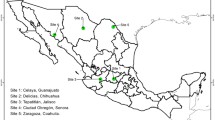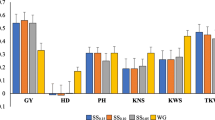Summary
The genetical and environmental control of yield and its components in spring barley, tillers per plant, grain number and grain weight has been investigated by triple test cross and linear modelfitting analyses.
Additive and dominance effects were observed for both grain number and grain weight, but tiller number was almost totally controlled by environmental factors. Epistatic effects were usually absent, only grain number exhibited such effects. The heritabilities of the yield components varied from low (0.15) for tiller number to high (0.51) for grain weight. Yield itself, measured on a single plant basis was mainly under additive and dominance control, with little evidence for epistasis. The heritability for single plant yield was low (0.22).
The possibilities for early generation selection for yield are discussed, and the relative contributions of each genetic and environmental component are described.
Similar content being viewed by others
Literature
Briggs, K.G.; Faris, D.G.; Kelker, D.G. (1978): Effectiveness of selection for plant characters of barley in simulated segregating rows. Euphytica 27, 157–166
Fiuzat, Y.; Atkins, R.E. (1953): Genetic and environmental variability in segregating barley populations. Agron. J. 45, 414–420
Frey, K.J. (1954): The use of F2 lines in predicting the performance of F3 selections in two barley crosses. Agron. J. 46, 541–544
Grafius, J.E.; Nelson, W.L.; Dirks, V.A. (1952): The heritability of yield in barley as measured by early generation bulked progenies. Agron. J. 44, 253–257
Hanson, P.R.; Jenkins, G.; Westcott, B. (1979): Early generation selection in a cross of spring barley. Z. Pflanzenzücht. 83, 64–80
Hayes, J.D. (1965): A study of early generation assessment in cereals with particular reference to barley. Ph.D. Thesis. Wales Aberystwyth (UK): University College
Jinks, J.L.; Pooni, H.S. (1976): Predicting the properties of recombinant inbred lines derived by single seed descent. Heredity 36, 253–266
Johnson, G.F.; Whittington, W.J. (1978): Inheritance of yield components and yield in relation to evidence for heterosis in f1 barley hybrids. Euphytica 27, 587–591
Kearsey, M.J. (1970): Experimental sizes for detecting dominance variation. Heredity 25, 529–542
Lupton, F.G.H.; Whitehouse, R.N.H. (1957): Studies on the breeding of self-pollinating cereals. 1. Selection methods in breeding for yield. Euphytica 6, 169–184
McKenzie, R.I.H.; Lambert, J.W. (1961): A comparison of F3 lines and their related F6 lines in two barley cultivars. Crop Sci. 1, 246–249
Pooni, H.S.; Jinks, J.L. (1976): The efficiency and optimal size of triple test cross designs for detecting epistatic variation. Heredity 36, 215–227
Pooni, H.S.; Jinks, J.L. (1978): Predicting the properties of recombinant inbred lines derived by single seed descent for two or more characters simultaneously. Heredity 40, 349–361
Pooni, H.S.; Jinks, J.L. (1979): Sources and biases of the predictors of the properties of recombinant inbred lines produced by single seed descent. Heredity 42, 41–48
Pooni, H.S.; Jinks, J.L.; Cornish, M.A. (1977): The causes and consequences of non-normality in predicting the properties of recombinant inbred lines. Heredity 38, 329–338
Rasmusson, D.C.; Cannell, R.Q. (1970): Selection for grain yield and components of yield in barley. Crop Sci. 10, 51–54
Riggs, T.J.; Hayter, A.M. (1973): Diallel analysis of the number of grains per ear in spring barley. Heredity 31, 95–105
Riggs, T.J.; Hayter, A.M. (1975): A study of the inheritance and inter-relationships of some agronomically important characters in spring barley. Theor. Appl. Genet. 46, 257–264
Surma, M.A. (1978): Diallel analysis of the number of spikes, number of spikelets per spike, 1,000 kernel weight and protein content in spring barley (Hordeum vulgare L.). Genet. Pol. 19, 377–401
Thomas, W.T.B.; Tapsell, C.R. (1983): Cross prediction studies on spring barley. 1. Estimation of genetical and environmental control of morphological and maturity characters. Theor. Appl. Genet. 64, 345–352
Valentine, J. (1979): The effect of competition and method of sowing on the efficiency of single plant selection for grain yield, yield components and other characters in spring barley. Z. Pflanzenzücht. 83, 193–204
Yap, T.C.; Harvey, B.L. (1979): Inheritance of yield components and morpho-physiological traits in barley, Hordeum vulgare L. Crop Sci. 12, 283–286
Author information
Authors and Affiliations
Additional information
Communicated by A. Robertson
Rights and permissions
About this article
Cite this article
Tapsell, C.R., Thomas, W.T.B. Cross prediction studies on spring barley. Theoret. Appl. Genetics 64, 353–358 (1983). https://doi.org/10.1007/BF00274179
Received:
Issue Date:
DOI: https://doi.org/10.1007/BF00274179




